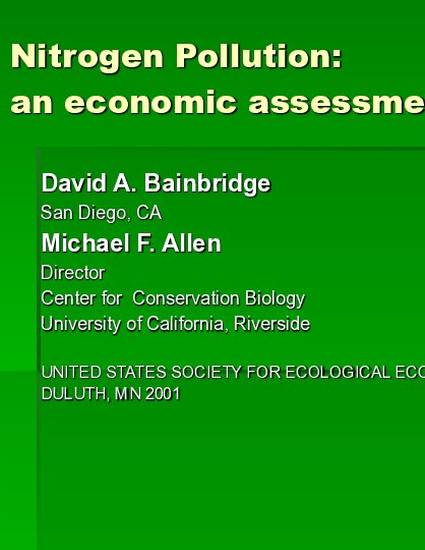
Presentation
Nitrogen pollution: an economic assessment
UNITED STATES SOCIETY FOR ECOLOGICAL ECONOMICS
(2001)
Abstract
Nitrogen deposition can reach almost 80 kilograms per hectare, considerably more than the world average application of nitrogen fertilizer on crops. Like the more widely recognized increases in global warming gases, increased levels of nitrogen can have profound affects on the biological world. Where the effect of excess nitrogen has been studied for long periods, the impact has been nothing short of catastrophic. By favoring plants, algae and organisms that are highly responsive to nitrogen, an excess of nitrogen reduces diversity and limits the ability of ecosystems to cope with stress. Exotic weeds and grasses can make wildfire deadly for people and ecosystgems. A classic study that began in the 1850s at Rothamsted Experimental Station in England, showed diversity dropping from twenty nine species to just three in plots with the highest nitrogen input. The economic cost is high yet rarely counted. Aquatic impacts like the Dead Zone in the Gulf of Mexico are acknowledged, but problems on land are ignored. An impact fee should be developed for reactive nitrogen. This would include cars, power plants, leakage from farms and other sources of reactive nitrogen. The cost to offset adverse effects of reactive N in nature reserves is extremely high.
Keywords
- nitrogen,
- reactive nitrogen,
- eutrophication,
- ecotoxicity,
- deposition
Disciplines
Publication Date
Summer July 11, 2001
Location
Duluth, Minnesota
Citation Information
Bainbridge, D. A. and M. F. Allen. 2001. Nitrogen Pollution: an economic assessment. UNITED STATES SOCIETY FOR ECOLOGICAL ECONOMICS Conference, Duluth, Minnesota. ppt. 29 pages.
Creative Commons License

This work is licensed under a Creative Commons CC_BY International License.
